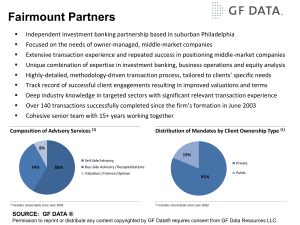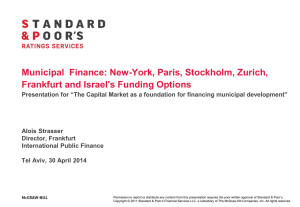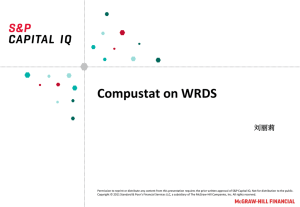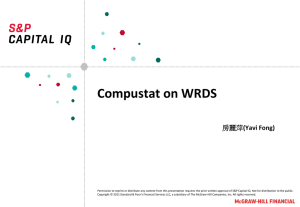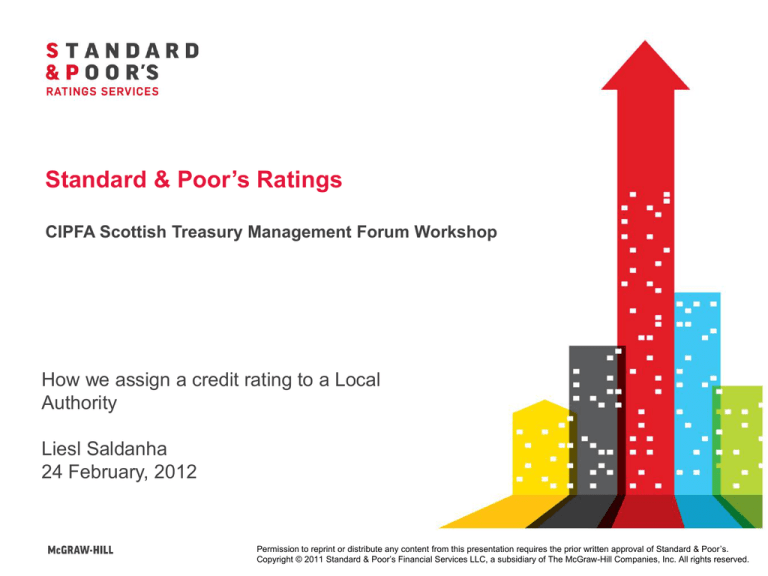
Standard & Poor’s Ratings
CIPFA Scottish Treasury Management Forum Workshop
How we assign a credit rating to a Local
Authority
Liesl Saldanha
24 February, 2012
Permission to reprint or distribute any content from this presentation requires the prior written approval of Standard & Poor’s.
Copyright © 2011 Standard & Poor’s Financial Services LLC, a subsidiary of The McGraw-Hill Companies, Inc. All rights reserved.
Structure of Presentation
1. Rating Definitions and Scales
2. Our View of U.K. Local Authorities
3. Rating Methodology for Local and Regional Governments
4. Process of Assigning a Rating
5. On-going Management Process to Maintain a Rating
Permission to reprint or distribute any content from this presentation requires the prior written approval of Standard & Poor’s.
2.
What is a Standard & Poor’s rating?
A rating reflects Standard & Poor’s current opinion of the
likelihood that the issuer will make payments of principal and
interest on a timely basis in accordance with the terms of the
obligation.
A rating does not constitute a recommendation to purchase,
sell or hold a particular security. In addition, a rating does not
comment on the suitability of an investment for a particular
investor.
Permission to reprint or distribute any content from this presentation requires the prior written approval of Standard & Poor’s.
3.
What is a rating?
Standard & Poor’s Rating Scale
AAA
AA
A
Stronger credit
quality
BBB
BB
B
CCC
CC
C
Debt default
D
Permission to reprint or distribute any content from this presentation requires the prior written approval of Standard & Poor’s.
4.
Ratings from « AA » to
« CCC » may be modified
by the addition of a « + » or
« - » sign to show relative
standing within the major
rating categories.
Outlook : Long term grades
may have a « stable »,
« positive » or « negative »
outlook.
An outlook indicates the
possible direction in which a
rating may move over the
next 18 to 24 months.
Our View of U.K. Local Authorities
• Our long-term ratings on U.K. local authorities range from ‘AAA’
to ‘AA-’. The main rating differences reflect financial
management, and the different levels of debt and reserves.
• Despite the major reductions in government transfers, we still
view the U.K. institutional framework as one of the strongest in
the world from a credit perspective.
• We are following the implications of the Localism Act 2011 and
the proposed reforms to business rates, which apply mostly to
local authorities in England and Wales. We believe a key issue
for Scottish local authorities, meanwhile, is likely to be the
implications for the Scottish Government of the outcome of the
Scotland Bill and the referendum on independence.
• We view the role of the PWLB as very significant, providing local
authorities with ready access to liquidity.
Permission to reprint or distribute any content from this presentation requires the prior written approval of Standard & Poor’s.
5.
U.K. Local Authorities Rated by Standard & Poor’s, December 2011
Issuer credit rating
Population
Kensington And Chelsea Birmingham
(Royal Borough of)
City Council
AAA/Stable/A-1+
AA+/Stable/-180,300
Greater London Transport For Woking (Borough
Authority
London
Council of)
AA+/Stable/-- AA+/Stable/A-1+ AA-/Stable/--
1,037,00
7,800,00
7,800,00
92,400
--Five-year averages (two years of actual data, current budget, and two years of Standard & Poor's forecast)-Operating balance (% of
adjusted operating revenues)
0.1
1.2
1.5
15.9
Balance after capital accounts
(% of adjusted total revenues)
-0.6
-3.0
-100.4
-7.0
7.0
-21.3
--Year ended March 31, 2011
Modifiable revenues (% of
adjusted operating revenues)
Capital expenditures (% of total
adjusted expenditures)
Tax-supported debt (% of
consolidated operating
revenues)
Interest
(% of operating
revenues)
Free cash & liquid assets (% of
debt service)
48.4
43.0
12.4
50.9
55.5
5.2
12.3
67.7
33.6
35.1
27.6
84.6
206.3
165.2
238.7
2.2
3.5
6.5
5.8
9.3
623.7
63.1
264.0
214.3
45.2
Permission to reprint or distribute any content from this presentation requires the prior written approval of Standard & Poor’s.
6.
Analytic Framework to Assess Credit Worthiness
Permission to reprint or distribute any content from this presentation requires the prior written approval of Standard & Poor’s.
7.
Overview of Standard & Poor’s Methodology
The analytical framework to rate non-U.S. local and regional
governments (LRG) consists of combined quantitative and qualitative
analysis around eight major factors:
•
Institutional framework
•
Economy
•
Financial management
•
Budgetary flexibility
•
Budgetary performance
•
Liquidity
•
Debt burden
•
Contingent liabilities
Permission to reprint or distribute any content from this presentation requires the prior written approval of Standard & Poor’s.
8.
Summary Chart
Permission to reprint or distribute any content from this presentation requires the prior written approval of Standard & Poor’s.
9.
Introduction and Overview
Permission to reprint or distribute any content from this presentation requires the prior written approval of Standard & Poor’s.
10.
Assessing the Institutional Framework
Permission to reprint or distribute any content from this presentation requires the prior written approval of Standard & Poor’s.
11.
Key Factors in Assessing the Institutional Framework
• Predictability:
• Frequency and extent of reforms affecting the intergovernmental system
• Predictability of their outcome
• LRG’s ability to influence or oppose reforms affecting their financial balance
• Revenue and expenditure balance:
• Overall adequacy of revenues to cover expenditure mandates, in the form of sufficient
autonomy or state subsidies
• Existence of a fiscal policy framework imposing prudent limits on LRG’s debt and
deficit levels
• Transparency and accountability:
• Transparency and institutionalization of budgetary processes,
• Disclosure and accounting standards for financial reporting in the LRG sector
• Control levels and reliability of the information
• Systemic support:
• Level of ongoing support from higher levels of governments to ensure the provision of
basic services and infrastructure
• Degree of systemic extraordinary support in exceptional circumstance
Permission to reprint or distribute any content from this presentation requires the prior written approval of Standard & Poor’s.
12.
Standard & Poor's, Institutional Framework Assessments, December 2011
Group 1 (predictable
and supportive)
Group 2 (predictable
and well-balanced)
Group 3 (evolving
but sound)
Group 4
(consolidating but
uneven)
Group 5 (developing
and unbalanced)
Group 6 (volatile
and underfunded)
Australian states and
municipalities
Belgian regions and
communities
Czech
municipalities
Brazilian states and
municipalities
Argentinean states
and municipalities
Belarusian regions
Australian municipalities
in the state of Victoria
Canadian provinces,
municipalities and
territories
French new cities
and French
Polynesia
Bulgarian
municipalities
Indonesian
municipalities
Nigerian states
Austrian states
French regions,
departments, cities and
intercities
Israeli municipalities
(tiers 1 and 2)
Colombian districts
Macedonian
municipalities
Philippine
municipalities
German states
German municipalities
in the state of NorthRhine Westphalia
Italian normal status
regions, provinces
and municipalities
Croatian
municipalities
Romanian
municipalities
Ukrainian
municipalities and
the autonomous
republic
New Zealand
municipalities
Italian special status
regions
Korean
municipalities
Hungarian
municipalities
Russian regions and
municipalities
Norwegian
municipalities
Japanese prefectures
and cities
Malaysian states
Latvian municipalities
Turkish municipalities
Spanish foral regions
Spanish normal status
regions and provinces
in foral regions
Polish municipalities
Mexican states and
municipalities
Swedish municipalities
and counties
Swiss municipalities in
Cantons of Geneva and
Vaud
Spanish
municipalities and
provinces
Swiss cantons
U.S. states
U.K. local authorities
Permission to reprint or distribute any content from this presentation requires the prior written approval of Standard & Poor’s.
13.
Assessing the Individual Credit Profile
Permission to reprint or distribute any content from this presentation requires the prior written approval of Standard & Poor’s.
14.
What our Individual Credit Profile Assessment Aims to Measure
Economy – score aims to measure how economic factors are likely to impact an LRG’s revenue
generation capability and spending needs, and ultimately its ability to service debt in the medium to
long term.
Financial Management – score aims to measure how the quality of an LRG’s financial management
and its political context are likely to affect its willingness and ability to service debt over time.
Budgetary Flexibility – score aims to measure how much an LRG could increase its revenues or
reduce its expenditure in case of need, in order to maintain its debt service ability.
Budgetary Performance – score aims to measure and forecast the level and the volatility of an
LRG’s expected cash flows from operations and capital activities, and its surplus available to service
debt.
Liquidity – score aims to measure how LRG’s internal sources of liquidity, such as cash reserves
and cash flow generation, and external sources, namely bank lines and market access, are likely to
impact its debt servicing capability, primarily within the next 12 months.
Debt Burden - aims to measure how our expectations for the level, structure, and sustainability of
an LRG’s debt are likely to affect its debt-service capacity.
Contingent Liabilities – aims to measure to what extent off-balance sheet risks and their relative
size are likely to impair an LRG’s capacity to repay its debt in the medium-to-long term.
Permission to reprint or distribute any content from this presentation requires the prior written approval of Standard & Poor’s.
15.
Assessing an LRG’s Economy
Rating Factors to assess the economic strength of an LRG:
• Wealth and Income levels
• GDP per capita: strength of tax base; expenditure needs
• Diversification of the economic structure
• Share of economic sectors in output and employment; employer concentration
• Assessment of potential volatility of tax base and resilience to stress
• Demographic Profile
• Impact of population structure and growth on LRGs finances
• Assessment of potential impact on revenues and expenditures, depending on
budget structure
• Growth prospects
• Analysis of past and forecast GDP performance in the context of national
economic development and competitive advantages or disadvantages of the LRG
Permission to reprint or distribute any content from this presentation requires the prior written approval of Standard & Poor’s.
16.
Assessing an LRG’s Economy
Permission to reprint or distribute any content from this presentation requires the prior written approval of Standard & Poor’s.
17.
Assessing an LRG’s Financial Management
We assess financial management, with a view to its effect on
creditworthiness, according to nine categories:
• Transparency and disclosure
• Budgeting
• Long-term capital and financial planning
• Revenue and expenditure management
• Debt management
• Reserve and liquidity management
• Management of government-related entities
• Political and managerial strength
• External risk management
Permission to reprint or distribute any content from this presentation requires the prior written approval of Standard & Poor’s.
18.
Assessing an LRG’s Financial Management
Score
Descriptor
Typical Characteristics
1
Very
Positive
The LRG has very prudent fiscal targets backed by widespread political support and implemented
by sophisticated managements. It has transparent and well-defined financial policies reflected in
reliable and public long-term planning and very good reporting. The management demonstrates a
high degree of expertise, through very good planning and monitoring, prudent and well defined
debt and liquidity management, and active external risk management.
2
Positive
The LRG has prudent financial policies and practices that ensure a good degree of transparency
and fiscal discipline through the electoral cycles. The management demonstrates relevant
expertise, through good planning and monitoring, prudent debt and liquidity management, and
some monitoring of external risks.
3
Neutral
The LRG has generally prudent financial policies, but they are frequently changed and may lack
precision. The management is transparent and has adequate expertise, through good though not
detailed planning and monitoring and generally prudent debt and liquidity management. But it may
lack a comprehensive strategy to manage external risks.
4
Negative
The LRG financial management is underdeveloped in some areas. In a stress scenario, the
government may lack the political strength to impose fiscal discipline reporting meets the legal
standard but is not very detailed and timely. Planning and monitoring are limited. The
management of debt and liquidity maybe unpredictable to a degree, while any external risk
mitigation is minimal.
5
Very
Negative
The LRG has a weak financial and credit culture, including poor monitoring and reported
information that meets just the minimum requirements to maintain a rating. A lack of political
stability makes it difficult to impose fiscal disciplines. The management lacks the relevant skills for
planning and monitoring. The management of debt and liquidity is unpredictable and sometimes
aggressive, while key external risks have not been identified.
Permission to reprint or distribute any content from this presentation requires the prior written approval of Standard & Poor’s.
19.
Assessing Budgetary Flexibility
Permission to reprint or distribute any content from this presentation requires the prior written approval of Standard & Poor’s.
20.
Assessing Budgetary Performance
Permission to reprint or distribute any content from this presentation requires the prior written approval of Standard & Poor’s.
21.
Assessing Liquidity
Permission to reprint or distribute any content from this presentation requires the prior written approval of Standard & Poor’s.
22.
Assessing Debt Burden
Debt burden analysis focuses on the following factors:
•
A forward-looking assessment of debt stocks and interest burden
Key indicators:
•
Tax supported debt to consolidated operating revenues, includes:
•
Direct debt & debt of tax-supported entities
•
LRG operating revenues & own revenues of tax-supported entities
•
Interest to adjusted operating revenues
•
Potential volatility on the cost of debt from exposure to market risks:
•
Interest rate risk
•
Currency risk
•
Use of derivative instruments
•
Debt maturity profile
•
An assessment of other long-term liabilities, mostly unfunded pension
liabilities
Permission to reprint or distribute any content from this presentation requires the prior written approval of Standard & Poor’s.
23.
Assessing Debt Burden
Permission to reprint or distribute any content from this presentation requires the prior written approval of Standard & Poor’s.
24.
Assessing Contingent Liabilities
• Mostly qualitative, with focus on:
– Nature of the risk
– Materiality
– Monitoring by LRG
– Availability of contingency reserves
• How do we assess risks?
– When individual entity or transaction represents over 20% of LRG op
revs: in-depth analysis
– When contingent liabilities are numerous but individually very small:
sector approach
Permission to reprint or distribute any content from this presentation requires the prior written approval of Standard & Poor’s.
25.
Assessing Contingent Liabilities
Permission to reprint or distribute any content from this presentation requires the prior written approval of Standard & Poor’s.
26.
Summary Chart
Permission to reprint or distribute any content from this presentation requires the prior written approval of Standard & Poor’s.
27.
Timetable for rating assignment
• An interactive process that generally takes about six weeks
Analytical team
assigned
Preliminary
research
Communication
to entity
Rating committee
Meeting with
entity
Publication of rating
(?)
Potential appeal
Rating
request
Surveillance
Permission to reprint or distribute any content from this presentation requires the prior written approval of Standard & Poor’s.
28.
Process to maintain a rating
• Please keep us informed – always
• At least one annual face-to-face meeting
• Information list will be provided well in advance of the annual
meeting.
• A collaborative relationship
Permission to reprint or distribute any content from this presentation requires the prior written approval of Standard & Poor’s.
29.
www.standardandpoors.com
Copyright © 2011 by Standard & Poor’s Financial Services LLC (S&P), a subsidiary of The McGraw-Hill Companies, Inc. All rights reserved.
No content (including ratings, credit-related analyses and data, model, software or other application or output therefrom) or any part thereof (Content) may be modified, reverse engineered, reproduced or
distributed in any form by any means, or stored in a database or retrieval system, without the prior written permission of S&P. The Content shall not be used for any unlawful or unauthorized purposes. S&P, its
affiliates, and any third-party providers, as well as their directors, officers, shareholders, employees or agents (collectively S&P Parties) do not guarantee the accuracy, completeness, timeliness or availability
of the Content. S&P Parties are not responsible for any errors or omissions, regardless of the cause, for the results obtained from the use of the Content, or for the security or maintenance of any data input by
the user. The Content is provided on an “as is” basis. S&P PARTIES DISCLAIM ANY AND ALL EXPRESS OR IMPLIED WARRANTIES, INCLUDING, BUT NOT LIMITED TO, ANY WARRANTIES OF
MERCHANTABILITY OR FITNESS FOR A PARTICULAR PURPOSE OR USE, FREEDOM FROM BUGS, SOFTWARE ERRORS OR DEFECTS, THAT THE CONTENT’S FUNCTIONING WILL BE
UNINTERRUPTED OR THAT THE CONTENT WILL OPERATE WITH ANY SOFTWARE OR HARDWARE CONFIGURATION. In no event shall S&P Parties be liable to any party for any direct, indirect,
incidental, exemplary, compensatory, punitive, special or consequential damages, costs, expenses, legal fees, or losses (including, without limitation, lost income or lost profits and opportunity costs) in
connection with any use of the Content even if advised of the possibility of such damages.
Credit-related analyses, including ratings, and statements in the Content are statements of opinion as of the date they are expressed and not statements of fact or recommendations to purchase, hold, or sell
any securities or to make any investment decisions. S&P assumes no obligation to update the Content following publication in any form or format. The Content should not be relied on and is not a substitute for
the skill, judgment and experience of the user, its management, employees, advisors and/or clients when making investment and other business decisions. S&P’s opinions and analyses do not address the
suitability of any security. S&P does not act as a fiduciary or an investment advisor. While S&P has obtained information from sources it believes to be reliable, S&P does not perform an audit and undertakes
no duty of due diligence or independent verification of any information it receives.
S&P keeps certain activities of its business units separate from each other in order to preserve the independence and objectivity of their respective activities. As a result, certain business units of S&P may
have information that is not available to other S&P business units. S&P has established policies and procedures to maintain the confidentiality of certain non–public information received in connection with
each analytical process.
S&P may receive compensation for its ratings and certain credit-related analyses, normally from issuers or underwriters of securities or from obligors. S&P reserves the right to disseminate its opinions and
analyses. S&P's public ratings and analyses are made available on its Web sites, www.standardandpoors.com (free of charge), and www.ratingsdirect.com and www.globalcreditportal.com (subscription), and
may be distributed through other means, including via S&P publications and third-party redistributors. Additional information about our ratings fees is available at www.standardandpoors.com/usratingsfees.
Permission to reprint or distribute any content from this presentation requires the prior written approval of Standard & Poor’s.
30.
STANDARD & POOR’S, S&P, GLOBAL CREDIT PORTAL and RATINGSDIRECT are registered trademarks of Standard & Poor’s Financial Services LLC.


